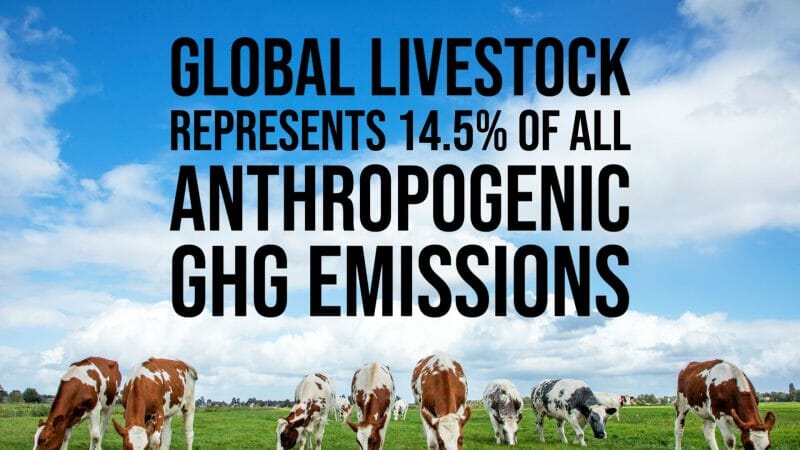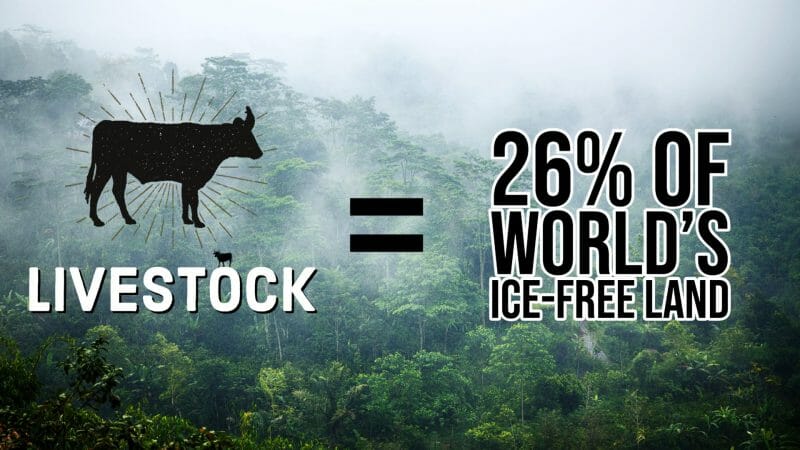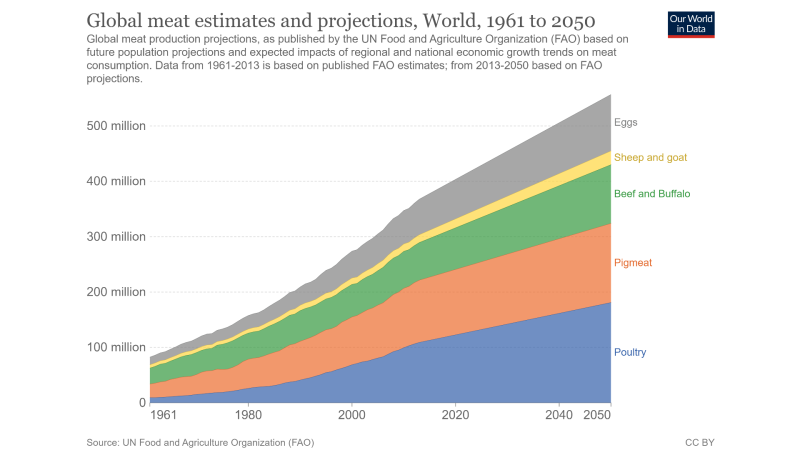Fear Versus Facts

You don’t know until you try. In my 25 years of existence, this was arguably the best piece of unsolicited advice I have received. Granted, it was given to me by the heroin addict outside of my London apartment, this advice still rings true today. With this in mind, having tirelessly scoured every inch of the plant-based sector for months, I think it’s finally time for me to give you my unsolicited advice.
At face value, the plant-based sector is pretty easy to understand, however, times have changed. It’s almost impossible to go a day without PETA referencing sources that are about as credible as The Onion. Unfortunately, it doesn’t stop at PETA. Reliable plant-based news is hard to come by nowadays, especially when multiple news outlets in the sector have extreme agendas.
Relying on sensational headlines and fearmongering, these outlets promote and provide a narrow-minded outlook on the plant-based sector. If you don’t believe me, check out Vegan FTA’s comic, “The Life of Farmed Animals – Male Chick Peter,” which depicts animal cruelty. Not exactly what I wanted to see this morning.
Don’t get me wrong, animal cruelty is disgusting, however, comics like this generalize the livestock industry as a singular evil. In reality, while the livestock industry is mostly comprised of deplorable companies, ethical livestock farming companies do exist. For example, Knee Deep Cattle Company is a cattle company recognized by Certified Humane® as an ethical farm. In terms of credibility, Certified Humane is a registered 501(c)(3) nonprofit certification organization operating internationally.
Headlines like The Guardian’s “Industrial Farming Is One of the Worst Crimes in History,” minimize the efforts of ethical companies like Knee Deep. In this same article, the author suggests that industrial farming isn’t just one of the worst crimes in history, but arguably the worst crime in history, period. I am not here to argue that point since it’s subjective and highly controversial. However, I do believe such a narrative is misleading and appeals to a very specific audience.
Before I am accused of having a pro-livestock farming agenda, here are my two cents. Livestock farming sucks. That being said, instead of denouncing all of humankind, let’s have a levelheaded discussion, starting with climate change. While transportation and industrial are two of the largest greenhouse gas (GHG) emitters, accounting for 29% and 23% of U.S. GHG emissions in 2019, respectively, the agriculture sector is still culpable.
In the same period, GHG emissions from agricultural soils, rice production, and livestock accounted for 10% of U.S. GHG emissions in 2019, representing a 12% increase from 1990. In total, global livestock represents 14.5% of all anthropogenic GHG emissions, according to the Food and Agriculture Organization of the United Nations (FAO). Breaking down these emissions, about 44% of livestock emissions are in the form of methane, 29% nitrous oxide, and 27% carbon dioxide (CO2).

Needless to say, livestock farming carries its fair share of the blame for rising levels of CO2 and methane in the atmosphere. Keep in mind, methane is more than 25 times as potent as CO2 at trapping heat in the atmosphere. However, methane has a shorter residence time of nine years, compared to a residence time of between 300 and 1,000 years for CO2. For context, residence time refers to the average time it takes for a molecule to be removed from the atmosphere.
Why is this bad? Put simply, trapping heat in our atmosphere, which contributes to climate change, can result in a variety of detrimental, long-term effects. This includes:
- rising sea levels
- increased permafrost thawing
- heatwaves
- heavy precipitation
- decrease in water resources
That’s just the tip of the iceberg. Seeing as we have lost 28 trillion tonnes of the Earth’s ice between 1994 and 2017, I should use that expression while I still can. Before I go off on a tangent, if you would like to know more about the effects of natural gasses like methane, check out this article. Now, let’s get into the actual meat of this article.
The Problem

Approximately 26% of the world’s ice-free land is used for livestock grazing, with 33% of croplands being used for livestock feed production. With this in mind, the livestock sector is one of the key drivers of land-use change. In fact, each year, roughly 13 billion hectares of forest area are lost due to land conversion for agricultural uses such as pastures and croplands.
In addition to fueling climate change, land conversion for agricultural use carries a variety of detrimental effects with it, including a reduction in regional water availability, soil fertility, and biodiversity, among others. Globally, if 40% of crops produced today for animal feed were instead used directly for human consumption, there would be enough cropland to feed 9 billion people in 2050.
However, the demand for animal products will continue to surge in the coming years. To be more specific, this demand is expected to increase by 74% for meat, 58% for dairy products, and a staggering 500% for eggs. Despite this, 1.03 billion tonnes, or 17%, of food produced globally each year is wasted.
The Solution

As so eloquently put by my girlfriend, an Environmental Scientist pursuing her Master’s Degree in Science and Sustainability Management, “Changing the livestock industry starts with changing our conscious purchasing decisions, thereby promoting more ethical business practices.” I couldn’t have said it better myself.
According to a study published in Anthropocene Magazine, there’s proof in the pudding. The study investigated whether an incentivizing approach would have greater success in getting people to switch from meat to vegetarianism as opposed to a punishing approach.
With this in mind, researchers carried out three experiments in a lunchtime canteen where participants could choose from one of four set meals varying from beef, chicken, tofu, or vegetables. Throughout the experiment, researchers utilized four approaches that might encourage participants to make ‘greener’ choices:
- labeling a meal choice by how green it is
- flagging some meal options as more favored by others
- applying a carbon tax to emission-heavy foods
- subsidizing plant-based meals
Even when paired with labeling techniques, the carbon tax was the least effective approach in getting people to make greener choices. However, when all four techniques were combined along with subsidies on plant-based meals, data demonstrated a surge in the number of people who opted for more sustainable food options. Ultimately, this demonstrates that subsidies may be more effective in promoting green purchasing decisions as opposed to imposing a carbon tax.
That’s not all. Researchers also calculated that over the course of the study, dietary changes led to a 24% decline in carbon emissions, as more consumers switched out meat-based options for the less carbon-intensive vegetarian meals. In total, if all four interventions were used to guide food choices over the course of a year, this experiment could cut an individual’s carbon footprint by up to 80 kg.
Bottom Line

Investing in plant-based is a no-brainer. Whether it’s sustainable packaging or meat alternatives, plant-based is the way to go. Considering 14% of the world’s population identified as vegans, vegetarians, and flexitarians, among other related categories, in 2021, I would say a good number of people agree with me. In the U.S. alone, the number of vegans grew to 3.5% in the last two years, with a total of roughly 9.7 million people in the US following a plant-based diet.
Sounds great, right? Not quite. As I mentioned at the start of this article, at face value the plant-based sector is easy to understand. That’s just it, though. More often than not, news outlets promote the misleading belief that a plant-based diet is a be-all and end-all that can save the world. The truth is, the plant-based sector is just as complicated, fragile, and diverse as any other sector.
Whether it’s Else Nutrition’s plant-based baby formulas or Planting Hope’s sesame milk, every plant-based company in the sector has a story to tell, however, that doesn’t always mean it’s pretty. Take Beyond Meat and Impossible Foods, for example.
Compared to the real deal, both the Beyond Burger and Impossible Burger contain substantially more sodium. To put things into perspective, compared to 4 oz of 85% lean ground beef, which contains 80 mg of sodium, a 4 oz Beyond Burger has 390 mg of sodium.

If you’d like to see how the Impossible Burger and Beyond Burger stack up against Actual Veggies, a sustainable plant-based company, check out this article. A study published in the MDPI Open Access Journals further supports the claim that not all plant-based products are nutritional.
In this study, researchers modeled a reference omnivore diet using NHANES 2017-2018 data. This data was then compared to diets that substituted animal products with either traditional or novel plant-based foods to create flexitarian, vegetarian, and vegan diets matched for calories and macronutrients.
Results demonstrated that, with the exception of vegan diets, all diets with traditional plant-based substitutes met daily requirements for calcium, potassium, magnesium, phosphorous, zinc, iron, and Vitamin B12. Additionally, diets with traditional plant-based substitutes were lower in saturated fat, sodium, and sugar compared to the reference diet.
On the other hand, diets based on novel plant-based substitutes were below daily requirements for calcium, potassium, magnesium, zinc, and Vitamin B12 and exceeded the reference diet in terms of saturated fat, sodium, and sugar. Yikes. Nutritional value aside, not all plant-based options are as sustainable as you’d think. Don’t believe me? Let’s take a look at the dairy alternatives market.
Almonds have built a reputation as a calorie and nutrient-dense food, yet many brands of almond milk may contain as little as 2% almonds. In total, that is the equivalent of three to four whole almonds. Furthermore, in addition to added sugar, many almond milk brands contain additives like lecithin, calcium carbonate, and water.
Although almond milk has one of the lowest greenhouse gas emissions and uses less land than dairy milk, almond milk requires more water than any other dairy alternative. More specifically, it takes approximately 130 pints of water to produce a single glass of almond milk.
To make matters worse, nearly 70% of commercial bees in the US are drafted every spring to pollinate almonds. Last year, it was estimated that one-third of these bees died from the pressures of this imbalance of growth.
My Unsolicited Advice
According to Bloomberg Intelligence, the Plant-Based Market is poised to exceed an impressive value of $162 billion within the next decade, fueled by a growing preference for sustainable, healthier foods. That being said, investing in plant-based really is a no-brainer. However, choosing sustainable, reliable, and profitable plant-based companies isn’t as easy. Off the top of my head, here are some companies worth checking out, in no particular order:
- The Planting Hope Company Inc. (MYLK.V)
- Else Nutrition Holdings Inc. (BABY.T)
- MeaTech 3D Ltd. (MITC.Q)
- CULT Food Sciences Corp. (CULT.C)
- NEXE Innovations Inc. (NEXE.V)
For the record, I own stock in NEXE, however, I do not hold a position in any of the other companies listed. Furthermore, non of the aforementioned companies are clients of Equity Guru, nor does Equity Guru own stock in these companies. With that out of the way, in an oversaturated sea full of generic plant-based meat alternatives, each of these companies brings its own unique spin to the plant-based sector.
In particular, cultured meat appears to be gaining traction, with the Cultured Meat Market expected to reach $2.7 billion by 2030, registering at a Compound Annual Growth Rate (CAGR) of 95.8% from 2022 to 2030. Ever since Mark Post created the first lab-grown beef burger in 2013, at a cost of roughly USD$330,000, the price of cultured meat has dropped substantially. While still a tad pricier than your average beef burger, cultured meat is inching closer towards price parity.
Next Big Thing?

For example, Future Meat Technologies, a cultured meat company, announced in 2020 that it was able to produce cultured chicken breast for USD$7.50. Shortly after, in June 2020, the company opened the world’s first lab-grown meat factory in Rehovot, Israel, where Future Meat was able to produce these same chicken breasts for just $3.90 each.
To top it all off, the company claimed that its production process led to yields 10 times higher than the industry standard while generating 80% less GHG emissions. If that wasn’t enough, Future Meat also boasted that it uses 99% less land and 96% less freshwater compared to traditional meat production.
Generally speaking, cultured meat could reduce GHG emissions by 78-96%, require 7-45% less energy, and use 82-92% less water, at least in the short term. As for the long term, a 2019 study published in Frontiers of Sustainable Food Systems found that the production of lab-grown meat could potentially generate greater concentrations of CO2.
To be more specific, the study, conducted by Livestock, Environment, and People, found that, in the long term, cultured meat production methods requiring large energy inputs would actually have a greater impact on climate change than some types of cattle farming if energy systems remain dependent on fossil fuels. With this in mind, the climate impact of cultured meat production will depend on its energy demand and well as the availability of low-carbon or net-zero energy solutions.
Sustainability aside, the mass adoption of cultured meat also raises some ethical concerns. By standard definition, cultured meat is created by painlessly harvesting muscle cells from living animals like cows, chickens, and pigs. Scientists then feed and nurture these cells so they will multiply to create muscle tissue, which is the main component of the meat we consume.
That being said, cultured meat is biologically the same as the meat tissue that comes from livestock. While this may sound like an ethical process, the production of most cultured meat still involves slaughter. Let me explain. In order to create cultured meat, a majority of production processes require fetal bone serum (FBS), which is extracted from fetal calves and is commonly used for cell growth.
However, the pregnancy status of a cow is usually unknown until after it has been slaughtered. When the fetus is exposed, FBS samples are not gathered until the fetus dies inside the uterus or has been immediately euthanized. It is also worth noting that one liter of FBS can cost up to £700, or roughly USD$950.

Thankfully, the cultured meat industry appears to be steering away from the use of FBS in the production process. In fact, Mosa Meat, a cultured meat company founded by Mark Post himself, has removed FBS from its process.
With global meat consumption expected to grow 40-70% by 2025, Mosa Meat has received backing from notable celebrities like Leonardo DiCaprio and has completed an $85 million Series B investment round.
In conclusion, with a little fine-tuning, the cultured meat sector could see some substantial gains, likely within the decade. That being said, now might be a good time to start scouting for potential investment opportunities in the sector. If you would like to see more articles like this, check out my Substack here! Thank you for reading.


Leave a Reply